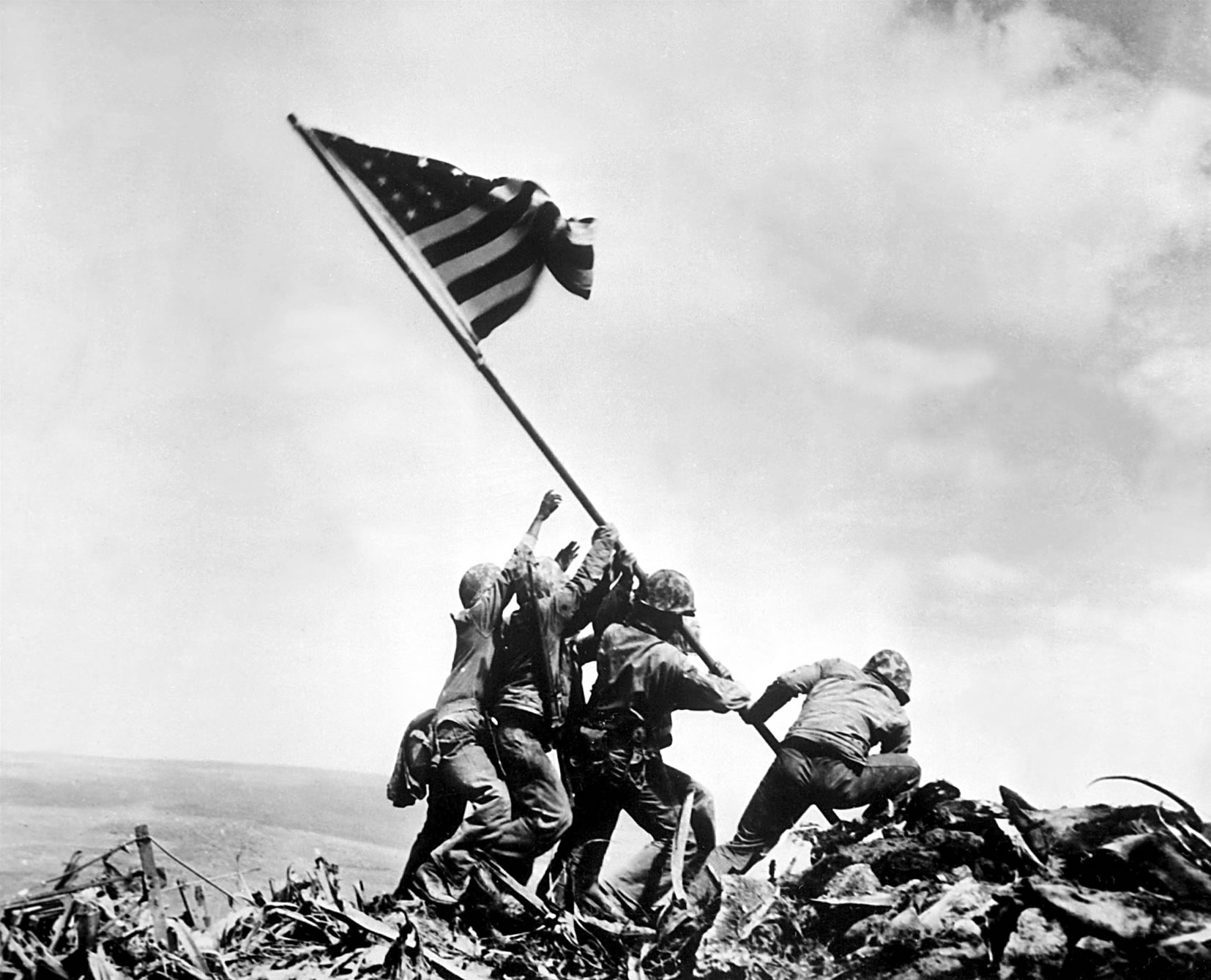
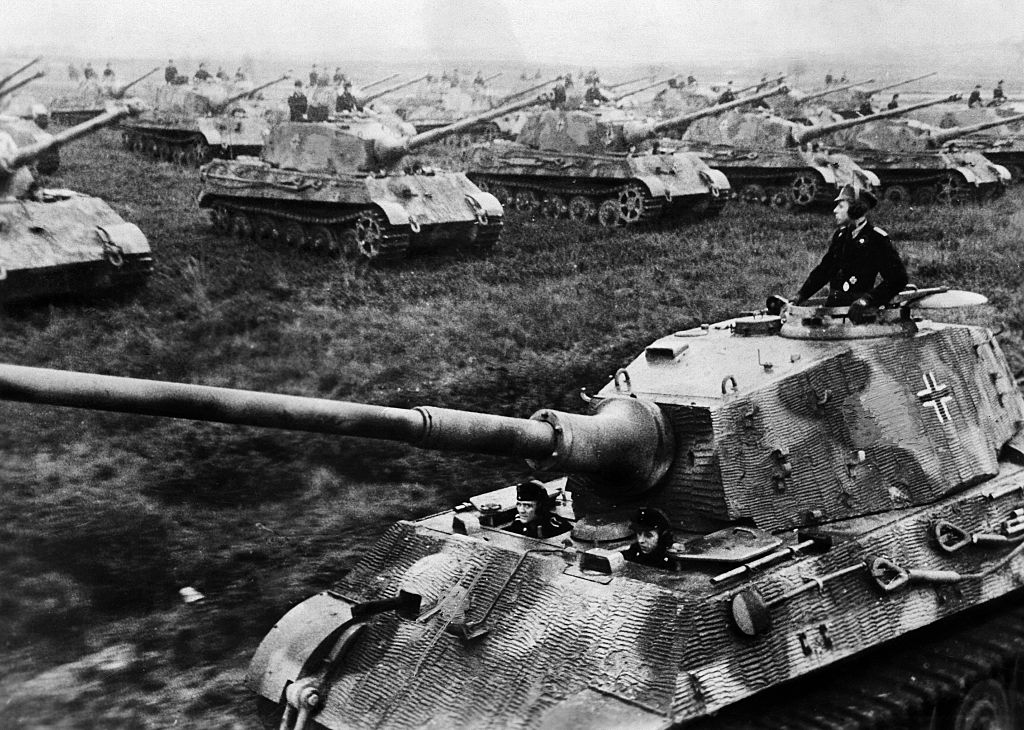
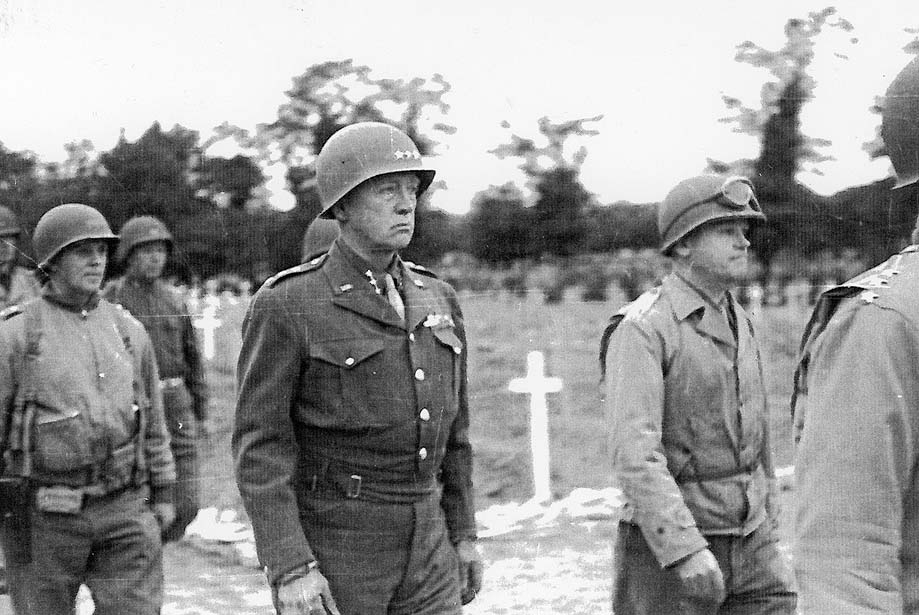
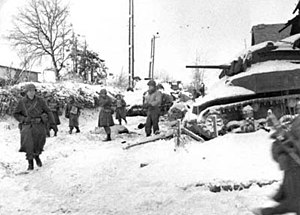
World War II
World War II was the bloodiest war in human history. Over 50 million human beings died in it. It has been studied massively by scholars among from across the spectrum of humanity. Also, it is a war that made us aware of the sacrifice of heroes who defeated Nazism. Like always, we memorize the victims of the evil Holocaust. World War II existed in many phases like the coming of war, the rise of fascist and authoritarian empires, the war itself, and the aftermath of World War II. World War II is directly related to WWI and the Great Depression. The event of WWI ended with many nations suffering economic recessions. Later, dictatorships would rise up that exploited the suffering of peoples in order for these authoritarian rulers to promote racism, bigotry, xenophobia, and ultimately genocide against innocent human beings. By November 1918, Germany surrendered to the Allied forces in ending World War One. The peace agreement was formed in 1919 with delegates from 27 nations. Most of the decisions in that agreement were established by America, France, and Great Britain. Germany and Russia weren’t there. The Treaty of Versailles was hated by Germany since it forced Germany to pay monumental reparations for its role in WWI. Italy and Japan wanted more from the deal too. Wilson thought that this agreement would end wars worldwide, but it didn’t. The 1920’s saw many countries move into democracy and freedom. Other nations came into the opposite direction in embracing dictatorships and totalitarianism. Totalitarianism means that a single party or one solitary leader controls every economic, social, and cultural aspects of people in one country. Totalitarianism would spread massively in the world by the 20th century. The 1917 Russian Revolution led Stalin to take power. Ironically, Lenin and especially Trotsky were critics of Stalin because of his totalitarian tendencies and his reckless actions. So, Joseph Stalin took power after the Russian civil war. That brutal civil war caused starvation, famine, and the deaths of millions of Russians. Lenin, before he died, moderated some of his economic policies.
By 1924, Stalin took over the Communist Party in Russia. Stalin was cruel, a murderer, and a tyrant. He regularly allowed the murder of his rivals and even fellow Communists who disagreed with him. He grew the industrial power of many farms. His Great Terror program murdered Communists who opposed him in the 1930’s. About one million people were imprisoned. The purge eliminated most of the leading officers of the Red Army plus others. Stalin promoted propaganda to maintain his vicious rule. He also violated religious freedom by destroying churches and suppressing religious expression throughout the Soviet Union. Stalin went so far that even to this day; many people falsely view every Communist and every socialist as equivalent to Stalin. Stalin ironically did more to slander socialism than any reactionary extremist could ever do. Italian totalitarianism rose after Italy being a victor of WWI. Ironically, Italy was once part of the Allied forces during WWI. Italy didn’t get lands on the Adriatic coast that it wanted. Italy experienced a depression after WWI as well.
Veterans in Italy had trouble to find work. The communist party was growing and the government had trouble in trying to adequately handle economic issues. Later, Benito Mussolini rose up in political power. He was once more liberal and then became a dedicated fascist. By 1919, Mussolini created the Fasci di Combattimento or the Fascist Party. This was a far right wing group that promoted nationalism and wanted to control Italy. He had his followers. They were the Black shirts. These criminals fought communists and socialists in the streets of Italy. Italian King Victor Emmanuel III feared revolution. So, he asked Mussolini to form a new government. Benito was called Il Duce or the leader. Benito controlled the government, the army, etc. after years of conflict. He later ended political parties. He controlled the press. He formed a secret police. He promoted brainwashing involving youth groups and Mussolini opposed strikes. He hated liberalism and socialism. Fascism was spreading like a cancer in the world.


The Further Rise of Fascism
For a time before the rise of Hitler and after World War One, Germany was a democracy. This was the Weimar Republic which was formed in the German town in Weimar. It suffered struggles because of the economic problems in 1920’s Germany. High inflation and huge economic troubles caused the Weimar Republic to be on the brink of collapse. By the 1930’s, the Great Depression was global and further harmed the Weimar Republic. Socialist groups were in existence desiring change. Also, antidemocratic far right groups were in existence like the National Socialist German Workers’ Party or the Nazi Party. They threatened the republic. The Nazis were not socialists. They hated socialism, communism, and other beliefs that promoted workers’ rights and class interests. Socialism believes in class struggle and racial equality while the Nazis believed in white supremacy and racism. Adolf Hitler was the leader of the Nazi Party. Hitler was the son of an Austrian civil servant. Hitler also was a decorated World War I soldier and a failed artist. He was near madness and he was completely evil. He joined the small Nazi Party after the war and ruled it later on. He was in prison because his party tried to cause a rebellion in an attempt to overthrow the Weimar Republic. His book that he wrote in prison was entitled, Mein Kampf or My Struggle. It scapegoated Jewish people, socialists, communists, etc. for the economic problems in Germany. He was very anti-Semitic and he hated Jewish people greatly. Anti-Semitism has been in Europe for centuries and Hitler promoted pseudo-scientific theories as a means to proclaim his racist ideologies. Mein Kampf was a national bestseller in Germany. This book wanted Nazis to have global domination and the extermination of Jewish people plainly speaking. The book falsely assumed that black people were inferior, which is a lie. Germany by the 1930’s had unemployment, hunger, homelessness, and economic collapse. The Nazis gained control by the Germany government by January 1933.
By that time, the president of the Weimar Republic appointed Hitler as chancellor of Germany. Hitler was later President and increased his power massively. Hitler made his powers unchecked by the German parliament or the Reichstag. In 1935, the Weimar Republic’s institutions were silenced. Hitler was the sole ruler of Germany. Hitler was a totalitarian like Mussolini and France. Hitler formed a secret police that crushed dissent. The state controlled press the praised him. He promoted Hitler Youth and the League of German Girls to indoctrinate the youth with Nazi ideas. By the late 1930’s, Hitler used rearmament and public works projects. The Germans cheered for him at Nazi rallies. He attacked Jewish people, communists, and socialists. Many Jewish people suffered abuse, discrimination, and murder by the Nazis and their supporters as well. Japan once saw democracy grow in the 1920’s. There were trade unions, men voting, and other parties formed. This ended with the Great Depression. By the 1930’s, Japan moved into a more militaristic direction. Japan had a constitutional monarchy ruled by one emperor. Japan used its military to attack Manchuria in 1931. They moved a more new regime called Manchukuo in Manchuria. They gained more natural resources in Asia by invasion. They also invaded China to steal Chinese railroads and coastal resources. They also conquered Nanjing where Japanese soldiers murder more than 200,000 Chinese people and many women were raped (called the Rape of Nanjing). Militarism spread in Italy, Germany, and Japan.
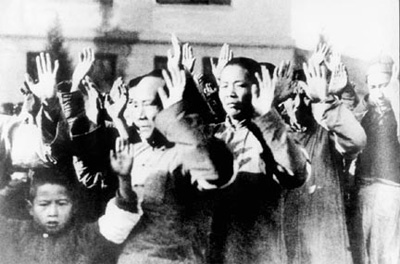

The League of Nations was very weak by America refusing to join it. The League of Nations had no army, no navy, and no power to enforce its proclamations. Hitler and Mussolini harmed societies. Germany’s economy grew from 1933 to 1936. He or Hitler wanted all Germanic peoples to be united in one Reich or state. He wanted to have Lebensraum or living space for Germanic peoples. He sent German troops to the Rhineland by 1936 and the League of Nations didn’t respond to stop him. Mussolini invaded Ethiopia in 1935, which was an independent African nation. Haile Selassie or the leader of Ethiopia wanted the League of Nations to respond and help them, but the League of Nations refused to do so. Ethiopia was conquered until years later when Ethiopia defeated the Italian invaders. Fascists fought in the Spanish Civil War. It lasted from 1936 to 1939. It was about the fascist nationalists fighting against Spain’s democratic Republican government. Hitler and Mussolini aided Franco and the Spanish fascists during the civil war. General Francisco Franco tested his military technology in the war. The Soviet Union aided the Republican forces. France, Britain, and the United States remained on the sidelines mostly (except for some Americans and other Westerners volunteering to join the Republican cause). The Fascists won the Spanish civil war unfortunately.

Isolationism vs. Interventionism
By the 1930’s, France and Britain wanted appeasement in dealing with the aggressive, fascist nations of Nazi Germany, etc. This wanted to make concessions to prevent enemy nations from going forward with all-out war and maintain peace. This policy didn’t work as the fascist leaders would be bolder to try to conquer more lands unjustly. Some appeasers viewed World War I as so bloody that they wanted peace at any cost. Some believed that the Soviet Union was more of a threat than Germany or Italy. Franklin Delano Roosevelt wanted a Good Neighbor policy with Latin America. He improved relations with the Soviet Union. Back then, at first, he didn’t take a forceful line against Germany aggression. He wanted to focus on its American problems and later embraced isolationism. FDR would later reject isolationism. Hitler in the spring of 1938 conquered Austria. He formed the Anschluss in Austria. He conquered Sudenteland in the fall of 1938. That region of western Czechoslovakia was many ethnic Germans living there. Britain and France appeased Nazi Germany during the Munich Conference. Hitler and British Prime Minister Neville Chamberlain plus French premier Edouard Daladier allowed Hitler to rule Sudetenland in order to try to get peace. Chamberlain came to London and praised the Munich Pact. He was wrong as war would occur 11 months later.
President Franklin Delano Roosevelt later condemned aggression in Asia and he did little to stop it. There was the 1937 attack on China. It shocked Americans and the rape of Nanjing would come in December of 1937. Japan attacked with no declaration of war. China experienced terrorism by Japan forces among its cities like in Shanghai and Nanjing. 3 American sailors were killed and the United States gunboat Panay on the Chang River was sank. FDR criticized Japan’s aggression in a speech in Chicago on October 5, 1937. He condemned Japanese attacks on civilian populations. He also said that no part of the war is truly isolated form the world. He wanted an alliance of nations to promote peace against aggression. He was criticized by many for his interventionist stance. Japan continued to invade more territories. France and Britain couldn’t stop Hitler’s aggression. Hitler conquered all of Czechoslovakia into German hands. This alarmed France and Britain. They started to prepare plans for a defensive measure against the Nazis. France and Britain said that if Nazi invaded other territories, then war would transpire. Britain and France signed an agreement with Poland aiding them if Hitler invaded Poland. Hitler wanted the Soviet Union to be a buffer against Poland. So, he or Adolf Hitler would not fight 2 fronts in a war.
That is why Germany signed the Nazi-Soviet Nonaggression Pact with the Soviets on August 23, 1939. They promised to not attack each other. They also agreed to invade and divide up Poland. This aggressive agreement shocked the world. It was one of the biggest mistakes of the Soviet Union. During the early mornings of September 1, 1939, Nazi Germany invaded Poland with a blitzkrieg strike. Fast moving tanks and soldiers conquered Poland. The Soviet Union invaded Poland from the east on September 17, 1939. France and Britain did nothing to help Poland. Poland was soon defeated by the end of September. World War II started with the Nazi invasion of Poland. The Axis Powers were Germany, Italy, Japan, and other nations. The Allies included Britain, France, and later other countries like America, China, plus the Soviet Union. During the spring of 1940, Germany invaded Denmark and Norway on April 9, 1940. By May 10, he used his blitzkrieg forces into the Netherlands, Belgium, and Luxembourg. His army was fast and powerful. Laster, he fought France. There was the Maginot Line and other areas. In May 1940, Germany moved into the Ardennes and British forces escaped form Dunkirk. Soon, France was defeated and conquered. It took only 35 days for Hitler to rule over France. The Nazis marched in Paris.

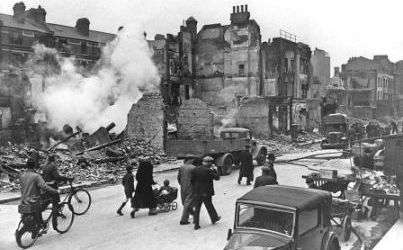
Winston Churchill gave speeches to Parliament and other places in England to fight the Nazi threat. He said on June 4, 1940 that he would fight everywhere against the Nazis and he won’t surrender. He rallied the British nation. They prepared for battles. Soon, Hitler invaded Britain via Operation Sea Lion. He or Hitler wanted the German air force of the Luftwaffe to bomb the British Royal Air Force. He wanted to control the British skies. The air battle continued between England and the Nazis. The Nazis attacked on July of 1940 starting the Battle of Britain. Almost 1,000 British planes were lost. More than 1,700 Nazi planes were lost. The Blitz included the Nazis destroying civilian infrastructure in Britain. Churches, homes, factories, schools, and other areas were bombed. Many British people lived in subways to escape the bombing campaign from Germany. Later, Hitler halted invasion attempts and the British were victorious. While this was going on, Winston Churchill wanted America to ally with him in fighting the Nazis. Many viewed this war as a fight for democracy globally. Nazis threatened human freedoms worldwide and that’s true.
Back then, America was mostly isolationist. President Roosevelt agreed with Churchill that the Nazi threat was real, but FDR knew that most Americans were opposed to U.S. intervention. The Great Depression was just ending. Many Americans wanted to focus on domestic affairs. The isolationist movement grew after the Nye Committee (named after Congressman Gerald Nye of South Dakota) saying that corporate interests benefited from World War One. Congress even passed the Neutrality Acts of 1935, 1936, and 1937. These laws used restrictions on American trade during the time of war. One example of this policy was Americans were forbidden to sail on ships owned by belligerents or nations at war. Americans were banned from making loans to belligerents or selling them arms and munitions. These laws didn’t make a distinction between aggressors like Nazis and Italy and victims like Poland or Great Britain and France. The interventionists wanted the support of America to giave great aid to the Allied cause.

Roosevelt was angry at the limitations of the Neutrality Acts. President Franklin Delano Roosevelt was anti-Nazi and promoted democracies. Congress passed the Neutrality Act of 1939. This act was different in that it makes it legal to have a cash and carry policy. This allowed belligerent nations to buy goods and arms in the United States if they paid cash and carried the merchandise on their own ships. The British navy controlled the seas. This policy allowed America to aid the British economically. Some Americans didn’t like Roosevelt’s pro-Allies stance. These people wanted isolation and neutrality even in the midst of millions of Jewish people dying by the Holocaust. Isolationists and interventionists debated each other greatly in 1940 and 1941. This came when Britain was alone in Europe fighting the Nazis. Some interventionists wanted to aid the British as a way to keep America out of the war militarily. One group promoting this view was the Committee to Defend America by Aiding the Allies. Isolationists wanted neutrality. They wanted no funding of Allies since they believed that it would ultimately cause war against the Axis. Many of the isolationists were indeed racists and pro-Nazis. The America First Committee was an isolationist group. Charles Lindbergh was one leading isolationist who condemned the Soviet Union and Japan while not massively criticizing the Axis Powers back then (until Pearl Harbor). The American First Committee had rallies nationwide. American journalist Edward R. Murrow reported news during the Battle of Britain. He exposed the fact that the Nazis were bombing civilian targets. This motivated interventionists to continue in the fight to defend democracy. Germany, Italy, and Japan had the Tripartite Pact in September of 1940. This agreement wanted each nation to defend each other in case they were attacked by another power.
Congress passed the Selective Service Act. This was a peacetime draft. It gave military training of 1.3 million troops and 800,000 reserve troops every year. Also, President Roosevelt aided Great Britain more. He gave 50 WWI era battleships in eight British defense bases. He did this without the consent of Congress as it was an emergency in his mind. FDR soon was elected for an unprecedented third time against Republican nominee Wendell L. Willkie of Indiana. Willkie accused FDR of not handling economic and foreign policy affairs the right way. Yet, most Americans wanted FDR to maintain the course of American society. Once re-elected, President Franklin Roosevelt supported Britain even more. FDR was short on funds from the cash and carry goods program. FDR addressed Congress on January 6, 1941. He spoke of the four freedoms. They were the freedom of speech, the freedom of worship, the freedom from want, and the freedom from fear. These freedoms were threatened by the Nazi and Japanese militarism. Roosevelt wanted America to aid the Allies in order to stop the Nazi empire. Roosevelt wanted to promote America as the “great arsenal for democracy.” Britain wanted help and America gave the UK help. In March of 1941, Congress passed the Lend-Lease Act. It was numbered 1776 after the big debate among isolationists and interventionists. The act gave Roosevelt the power to send and lease plus lend resources to allies in defense of America. By 1945, America sent more than $40 billion of Lend-Lease aid to the Allies plus to the Soviet Union. It was an act of economic war against the Nazis and the rest of the Axis Powers.
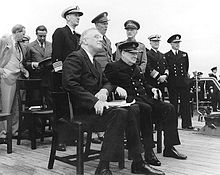
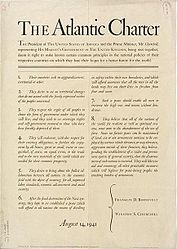
The historic Atlantic Charter promoted an alliance among Great Britain and America. It occurred on August of 1941. This was when President Roosevelt and Prime Minister Winston Churchill met secretly on a warship of the coast of Newfoundland. They walked about the British response in the world. They also wanted to talk about the future after the war ended and after Hitler was defeated. Both of them signed the Atlantic Charter, which promoted national self-determination and an international system of general security. Roosevelt was more apt to oppose colonialism while Churchill is well known to have supported colonialism including the concept of the British Empire. Hitler knew of these things. He knew America was funding the Allies. So, he responded. American ships escorted arms shipments to Iceland and the British picked them up and sent them to England. By the fall of 1941, Hitler used German U-boats of submarines to attack American ships. Many U-boats shot at the USS Greer, hit the USS Kearny, and the USS Rueben James. Over 100 sailors were killed by these acts. Many Americans were angered. This was close to America declaring war on Germany. America by this time was a neutral nation, but that would change. FDR ordered the Navy to attack German U-boats on sights. By June 1941, the Nazis declared war on the Soviet Union via Operation Barbarossa. This was his greatest mistake since the Soviet Union would mobilize its factories and army to help end the Nazis. The Soviets used millions of its people to organize factories, soldiers, and other resources to respond plus defeat Nazi Germany. By November of 1941, America would be closer to have involvement in World War Two militarily.

America Enters the War
America came into World War II after Japan’s attack in America. It started by December of 1941. Japan and America were once allies during WWI. Later, things have changed. Japan expanded its militarist empire throughout Asia and the Pacific region. America had forces in Guam and the Philippines. Japan considered this reality a threat to its acquiring of natural resources. Yet, Japan still traded with America. The U.S. supplied Japan with oil and other resources too. Japan took over China and Vietnam (which was called Indo-China back then). President Roosevelt wanted this expansion to end. July 1940 was the time when FDR placed an embargo on naval and aviation supplies to Japan. These supplies included oil, iron ore, fuel, steel, and rubber. FDR made a bigger embargo after the Tripartite Pact was made in 1940. Japanese expansion slowed down. Yet, Japan continued to conquer more territories. General Hideki Tojo was the new Japanese prime minister in 1941. He was called the razor for his sharp mind. He wanted military expansion and keep America neutral. In the summer of 1941, both America and Japan were in serious negotiations in order to end disagreements. Japan wanted to expand while American leaders were opposed to this goal. Japan’s final demands were rejected by U.S. Secretary of State Cordell Hull in 1941.Tojo tried a final peace initiative, but failed. Tojo decided on fighting America via war. During the beginning of December, Japan would strike America in Hawaii. Japanese diplomats were in D.C. while Japanese ships headed for Pearl Harbor. Pearl Harbor had a major amount of U.S. naval ships. Tojo sent Vice Admiral Chuichi Nagumo to command the attack. He had 6 aircraft carriers, 360 airplanes, and many battleships plus cruisers. There were submarines there too. Japanese wanted a surprise attack in order to end American military forces in the Pacific. Japan wanted to expand into new territories to gain resources.
The Japanese attack on Pearl Harbor was brutal. American forces were surprised by the attacks. The USS Arizona was destroyed. The USS Arizona was blown up. Nearly 2,500 people were killed. 8 battleships were severely damaged, 3 destroyed left unusable, and 3 light cruisers were damaged. 160 aircraft were destroyed and 128 more were damaged. The U.S. battle fleet was out of commission for almost six months. The Japanese had access to get new raw materials in new territories. Much of the U.S. aircraft carriers were out to sea in that time. The USS Arizona, the USS Oklahoma, and the USS Utah suffered harsh damage. Nagumo canceled a third wave of bombers. He came back home since he didn’t wanted an American counterstrike. The American Pacific Fleet would recover. As news about Pearl Harbor spread in America, FDR addressed Congress. He promoted unity to fight the Japanese. Nothing was the same. Most Americans soon desired to declare war. The Soviet Union now was in the Allied cause. Political infighting ended between isolationists and interventionists. The only people who opposed involvement in the war were pacifists, isolationists, and others. President Roosevelt gave a speech to promote the declaration of war. Congress supported the declaration of war in the House 388 to 1 and in the Senate unanimously. Later, Japan, Germany, and Italy declared war on America. Democrats and Republicans were in the war effort. Patriotism increased. Many Americans mobilized for the war effort. Some were in the military, some joined other organizations, and some funded the Red Cross. 16 million Americans joined the military in the war. The U.S. Army grew from about 1.4 million to 3 million people. The Navy grew from under 300,000 to more than 600,000 people.


Americans of every ethnicity and sex were involved in World War II. 300,000 Mexican Americans and 25,000 Native Americans were in integrated units. Nearly one million African Americans joined the military in mostly segregated units. They first worked in limited roles at first. Later, African Americans saw more active combat and served in the white combat units in some cases. This came after causalities mounted. Over 350,000 women served in World War II in a diversity of roles. In 1941, Congresswoman Edith Nourse Rogers introduced a bill formed the Women’s Army Auxiliary Corps which would change into the WAC or the Women’s Army Corps in 1943. The WAC allowed women clerical workers, truck drivers, instructors, and lab technicians to work for the United States Army. Over 150,000 women served in the WAC. 15,000 women served overseas. 600 women received medals for their service. The Army Nurse Corps had 57,000 nurses. These nurses were in danger from the Axis in Europe and in the Pacific. Thousands of more women were in the Navy and Coast Guard auxiliaries. Industry would mobilize too. Roosevelt inspired American production of industry to be used in the war. The War Production Board or the WPB oversaw the conversion of peacetime industry into a war industry. Many agencies made materials to promote resources for the war. Civilian goods were regulated. Organized labor negotiated with the government too. All of these things were controlled with the help of the OWM or the Office of War Mobilization. Defense spending massively ended the Great Depression.
That spending was government money which proves the notion that government intervention can end recessions and depressions. A job came for every worker who wanted one. Production for military supplies increased. Henry Ford produced for America. American made production much more than Axis nations combined by 1944. American production was key in causing the Allied victory of World War II.
After Pearl Harbor, Japan moved as quickly as possible in the Pacific in order for them to control areas before a major American response. In December 1941, Douglas MacArthur struggled to secure the Philippines. The Philippines had little support. Japan destroyed half of the Army’s fighter planes in the region. Japan quickly controlled Guam. They also took Hong Kong and Wake Island. Japan attacked the Philippines by December 22, 1941. MacArthur used his forces to try to stop the Japanese. Yet, the Japanese had bigger numbers, so MacArthur and his forces were forced to retreat. The U.S. left Manila to the Bataan peninsula. They dug in for a siege on Corregidor. Americans suffered heavily and many had low rations. MacArthur left into Australia via evacuation by orders from the U.S. government. Other Americans remained behind. They held out until May of 1942. This was when 75,000 troops surrendered. They were taken as POWs to march 55 miles to the Bataan peninsula to go into a railway. They were forced to march 8 more miles. More than 7,000 Americans and Filipino troops died during the Bataan Death March. Japanese forces continued to get more lands in the Pacific. They got oil and rubber plies in the Southeast Asian region. By the summer of 1942, Japan thought about dominating the Indian Ocean, Australia, New Zealand, and the central Pacific. America had to act quickly to prevent that from happening.
FDR led a response against Japan. This was the Doolittle Raid. It involved a nighttime bombing raid from the USS Hornet aircraft carrier. It was led by Colonel James Doolittle. Doolittle led the raid of 16 B-25 bombings to attack Tokyo. The raid killed 50 Japanese people and damaged 100 buildings. The pilot flew to China where they crash landed. The Doolittle Raid was a small military gain, but it gave Americans more confidence. The Battle of Coral Sea was used to fight Japan. In May of 1942, Japanese moved to take Port Moresby in New Guinea. The Japanese wanted to attack Australia later on. They also wanted to protect its military bases at Rabual, New Guinea. America sent 2 aircraft carriers. They were the USS Lexington and the USS Yorktown along with support vessels to attack the Japanese forces. On May 7-8, 1948, American and Japanese forces fought each other via aircraft. The battle was a draw, but it further gave Americans forces confidence to continue. Aircraft carriers and planes were key weapons in WWII. Japan no longer attacked New Guinea in the future. 1942 saw the Allied response against the Axis Powers to exist in a higher level.

The Allies Winning
June 1942 was a time of the Allied forces were still responding and fighting the Axis Powers. The Axis Powers never had a long term strategy in their goals. Hitler wanted to rule Europe and murder Jewish people, Communists, socialists, plus non-white Germanic peoples. Mussolini wanted an empire from Italy to East Africa. Tojo wanted to dominate Western Pacific areas and Asia. The Allied forces had a more unified purpose. Roosevelt, Churchill, and Stalin wanted Nazi Germany defeated. America created tons of materials for the Allies, but the Allies fought Nazi U-Boats in order for the Allies to carry those supplies to the UK, the Soviet Union, and other Allied forces. German U-Boats sank more than 3,500 merchant ships and murdered thousands of Allied seamen in the Atlantic and Caribbean waters. By mid-1943, the Allied forces used radar to track and destroy German U-Boats. Long range bombers defeated many U-boats too. Germany attacked Russia in 1941. The Nazis send one army north to Leningrad and a second one east toward Moscow. They also had a third group going south to Stalingrad. The Nazis were deep in the Soviet Union. Millions of Soviet soldiers and civilians were killed. The Soviet resistance and the Russian winter ended the Nazi advance. Hitler also wanted to capture Stalingrad in order to get the rich oil fields of the Caucasus Mountains. The battle of Stalingrad was long and harsh. German troops had house by house fights. The Soviet troops counterattacked. The Nazis were trapped. Hitler resisted defeat at first. The remaining German troops surrendered on January 31, 1943. The battle of Stalingrad was a turning point in the war. It was the end of the Hitler advance in the east. Hitler never could dominate Europe. Nazi armies were in retreat and came back toward Germany. The Soviet Union was now in the offensive going westward into Berlin.
There was World War II battles in North Africa too. In the deserts and mountains of North Africa, Germany and Britain fought each other for territories. The British were fighting the Germans and the Italians since 1940. The Allied forces wanted North Africa. Stalin wanted America and Britain to fight the Nazis in France in order to cause a second European front (plus give Stalin more freedom to fight). FDR and Churchill wanted to go into North Africa at first instead. Both thought that they needed more time to go into France from the English Channel. FDR and Churchill wanted to get North Africa, so they could go into Italy. By October of 1942, the British won a major victory at El Alamein in Egypt. The British moved westward. Allied troops landed in Morocco and Algeria and started to move east toward key German position. The Allied invasion of North Africa was started by General Dwight Eisenhower, who was an American. German general Erwin Rommel on February of 1943 led his Afrika Korps against the Americans at the Kasserine Pass in Tunisia. He was called the Desert Fox. Rommel broke through the American lines. He wanted to go to the Allied supply base at Tebessa in Algeria. American soldiers stopped the Rommel assault. Rommel retreated after he lacked the supplies to carry onward. The Kasserine Pass victory inspired Americans. They or the Allies wanted aggressive officers and troops who were trained at desert fighting. Eisenhower put the American forces in North Africa under the command of George S. Patton Jr. He was a tank commander and an expert strategist. Patton’s forces went east. They had confidence. At the same time, the British forces went westward from Egypt. They trapped the Axis armies. The Nazis decreased in power at Tunisia. Rommel escaped and his army didn’t win. By May of 1943, German and Italian forces surrendered with about 240,000 troops.

By 1943, the Nazis were on the defensive. January of 1943 was the time when Roosevelt and Churchill met at Casablanca, Morocco to plan their next moves. They decided to bomb Germany and invade Italy. FDR wanted the Allies to only accept unconditional surrender. FDR didn’t want Hitler, Mussolini, or Tojo to have some negotiated peace. FDR wanted complete victory. The Allied forces invaded Italy. First, they came to Sicily since it had little U-Boats and it was an island. By July 1943, British and American armies came into Sicily. Eisenhower commanded the joint American-British forces to strike. The Axis escaped into the mainland of Italy. The 38 day campaign caused the Allies to control the western Mediterranean. It paved the way for the invasion of the Italian mainland. It also ended the rule of Benito Mussolini years later. Italy surrendered on September 3, 1943. 5 weeks later, Italy declared war on Germany. Hitler didn’t give up on Italy yet. Mussolini was rescued by a German airborne force from a mountaintop fortress. Hitler made him a puppet leader of northern Italy. In southern Italy, the Nazis fought against the Allies.
The invasion of Italy by the Allies wasn’t easy. Italy had massive mountains, heavy rains, and tough terrain. Allied forces would not completely defeat the Axis until 1944, but the Allied force would have many victories in the fight for Italy. Stalin continued to want America and the UK to invade France. Yet, both nations would fight in different ways. British bombers attacked German cities in the saturation bombing. They wanted to make maximum damage. The American bombers targeted Germany’s political and industrial centers. The Americans used strategic bombing to destroy the Nazi’s power to make war. The African American fighter squadron called the Tuskegee Airmen escorted bombers and protected them from enemy fighter pilots. In more than 1,500 missions over enemy territories in Europe, the Tuskegee Airmen didn’t lose a single bomber. The Allied bombers experienced a high causality rate overall. During the day and night, German targets were bombed. It caused relief on Soviet forces to fight in the Eastern Font and go into Berlin ultimately.
The Battle in the Pacific continued. In May of 1942, Japan continued to advance in the Pacific. They attacked colonies controlled by America, Britain, and the Netherlands. They controlled the Philippines, Malaya, Dutch East Indies, Hong Kong, Wake Island, Guam, and Burma. Later, America fought back. Americans triumphed at Midway. Admiral Yamamoto was the commander of the Japanese forces in the Pacific. He realized that the United States Navy was a powerful force. Yamamoto wanted to destroy the U.S. aircraft carriers in the Pacific. He wanted to defeat the naval base in Midway. Midway is in the Central Pacific. It helped to defend Hawaii. Losing Midway would force the American forces to go into California. Yamamoto wanted Midway and the Aleutian islands in Alaska. Admiral Chester Nimitz or the commander of the United States Navy in the Pacific knew of the Japanese plans. Navy code breakers intercepted Japanese messages. Nimitz sent American forces to Midway. The Japanese navy was stretched out more than 1,000 miles. American forces were near Midway. Japanese attacked on June 4, 1942. It was a great naval battle. America defeated Japan. Torpedo planes and dive bombers sank 4 Japanese aircraft carriers along with 22\50 aircraft on board. Many of Japanese great pilots lost their lives. The Battle of Midway was a turning point of the war in the Pacific. It proved that the Japanese forces weren’t all powerful. Japan would never again threaten Hawaii or dominate the Pacific. Japan was on the defensive after the Allied victory of Midway. August 1942 was when American forces were on the offensive. They assaulted Guadalcanal in the Solomon Islands. The United States Marines drove the Japanese off the island on August of 1942. Guadalcanal was the first leg in a strategy to approach Japan from both the southwest Pacific and the central Pacific. The Allies had U.S. Marine, Navy, and Army forces. They wanted Japan to fight a two front war. The Allied forces would get islands. Many places had monsoons, heat, coral reefs, and jungles. The journey to go to Japan would be one long enacted by the American forces.
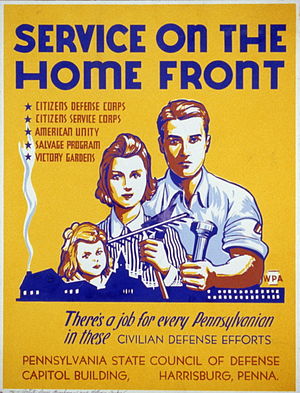
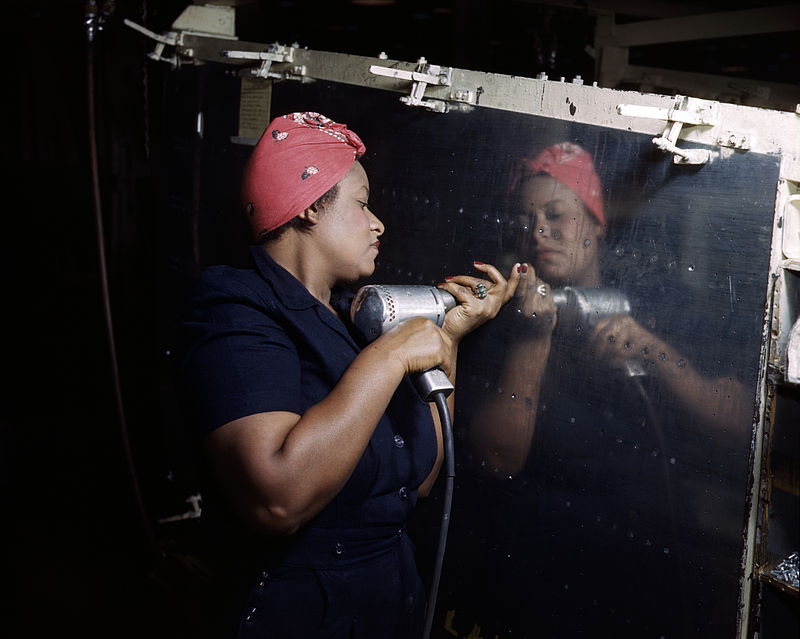

The Home Front
In the United States of America, World War II changed the lives of Americans forever. Patriotism grew. Many economies recovered. There were more opportunities for women, black people, and other people of color. The problem was that also racism, discrimination, sexism, and violations to civil liberties were abundant during this time. America’s economy was in a war production economy heavily. Government encouraged women to work in industrial jobs while many men were off to war. Women in about three-fourths worked in the war industries and were married. About 60 percent of the women workers were older than 35 years old. The image of Rosie the Riveter working gave Americans of an image of women in wartime production. Women worked in blue collar and white collar jobs. After the war, more women fought for better employment. By the 1940’s, women were increasing in secretarial jobs. Women used devices to create metal. Many had more paychecks and inspired their daughters to carry onward in their dreams and aspirations. Daycare existed and many mothers allowed their neighbors to baby sit their kids while they were off to work.
Also, African Americans fought for freedom too in America during World War II. Many black Americans wanted the war to give black people more economic opportunities and end Jim Crow oppression and racism in general. Yet, national defense employers didn’t employ many African Americans in meaningful jobs. Out of 100,000 Americans working in the aircraft industry in 1940, only 240 workers were African Americans. Segregation was in government and military jobs. That is why African Americans promoted the Double V movement which wanted to end fascism overseas and end racism at home in America. A. Philip Randolph was a civil rights leader who didn’t want black people to have second class citizenship. He wanted freedom for black Americans. He demanded that President Franklin Delano Roosevelt would end discriminatory actions in government funded training, employment, and the armed forces. He or Randolph planned to have a march on Washington, D.C. to protest racism and discrimination. FDR wanted to place the issue of civil rights on the backburner since he feared the political backlash from southern white racist Democratic segregationists. A. Philip Randolph persisted with his demands. Only Eleanor Roosevelt inspired Randolph to end his plans and FDR issued the Executive Order 8802. This order banned racial discrimination involving government funded defense military jobs. It formed the Fair Employment Practices Committee to enforce this policy. It was the first anti-racist policy from the federal government since the end of Reconstruction.
African Americans joined the NAACP in larger numbers to about 500,000 members. By 1942, CORE was created or the Congress of Racial Equality. CORE wanted to use protest to end segregation. These groups inspired the development of the modern day civil rights movement that would grow into the next level by the early 1950’s. The Second Great Migration occurred during this time among black Americans. Also, Americans in general migrated into urban areas from cities in California to Detroit plus Chicago. Billions of dollars came into many areas of the South and the Southwest to build industries. Native Americans worked in defense industries too. Many Mexican Americans worked in farms called the bracero program. Migration wasn’t accepted by all Americans. The summer of 1943 saw many racial riots in America.

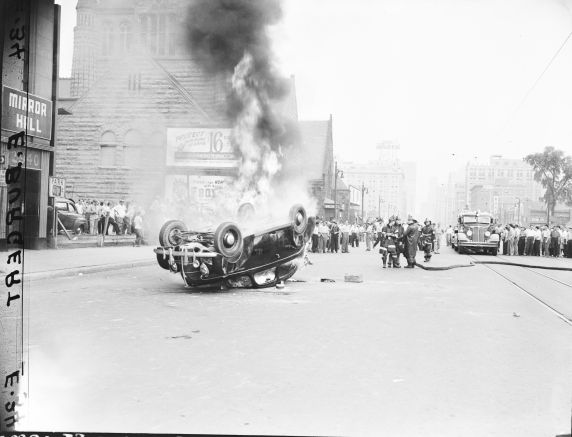
The Detroit riot of 1943 was very violent. It started when housing for black workers existed. Black people worked in defense plants. Many white racists falsely scapegoated black people for economic issues when black people were just living in Detroit and working. Some 100,000 white people and black people fought in a city park. The next morning, the riot was larger and federal troops had to be called to end the violence. Detroit continued to deal with many issues years and decades to come. Mexican Americans were also scapegoated. Many lived in poor areas of Los Angeles and the West. Some didn’t speak English. Many Mexicans and Mexican Americans wore zoot suits as a way for them to promote confidence in their own style and heritage. Later, white sailors in June of 1943 violently attacked Mexican Americans in the zoot suit riots. The police arrested the Mexican victims not the attackers. Also, the racists attacked black and Filipino Americans in Los Angeles too. Lieutenant governor Earl Warren wanted an investigation and people knew who started the riot (which were the sailors). He wanted those responsible to be punished. Yet, the sailor criminals weren’t readily punished.


The aftermath of Pearl Harbor unfortunately caused more anti-Japanese racist sentiment in America. Many Americans falsely blamed every Japanese person for the actions of a few. This racism inspired the evil internment camp system against Japanese people. Even immigrants from Axis countries had to have fingerprints, affiliations revealed, and other authoritarian measures. These violations to civil liberties are not justifiable period. 11,000 German Americans and Italian Americans were held in detention camps too. FDR promoted his executive order 9066 which caused many areas to be war zones where Japanese Americans were removed from the West Coast into internment camps. These internment camps for Japanese people were found in Arizona and Native American reservations. Nisei and Issei were interned in such camps for the rest of the war. Some Japanese Americans went to court to attempt to end this evil. The Supreme Court in the 1944 case of Korematsu v. United States upheld the wartime policy of internment of Japanese Americans. Reparations in the form of $20,000 per internment victim would be done by 1988 when Ronald Reagan was President. Japanese Americans were banned from joining the Armed forces until 1943. The all-Nisei 442nd Regimental Combat Team fought in the Italian campaign and was the most decorated military unit in American history. They helped to refute the lie that Japanese Americans were not loyal citizens.
$330 billion was the cost of the war. The debt increased. America issued revenues by having a 5 percent tax on all working Americans. War bonds were brought to save money and investments existed. The war continued and it caused a scarcity of consumer products. Shortage had price increases. FDR created the Office of Price Administration to handle rationing, inflation, and the costs of goods. Coupon books limited the supplies that Americans could buy in order to fund the war effort. The Office of War Information or the OWI promoted the war effort by using the media and movies. The problem with the OWI is that it tried to minimize the issues of poverty, racism, and real injustices in America with their movies, TV shows, and other items of media. It was right to say that fascism and dictatorship have no place in the world and there is greatness in democracy. Frank Capra’s Why We Fight promoted the Allied cause. Some movies had shown racist, stereotypical images of Japanese people. Many people in America scarified to plant gardens, sell medal, and give money to support the cause of the Allies.

:max_bytes(150000):strip_icc()/c051107378bbbe284b75100dfc360088-5933c54c3df78c08aba52512.jpg)
The Allied Victory in Europe and in the Pacific
The Nazis were pushed back from Russia by 1943. 1944 and 1945 saw the end of the Axis Powers. In 1943, Churchill, Roosevelt, and Stalin disagreed on the time to execute a second front in France. Stalin wanted England and America to fight in France since the Soviet Union had most of the military burden in the European theater. Roosevelt understood Stalin’s views, but Churchill had a total hatred of Communism. He didn’t trust Stalin at all, but realized that he needed Stalin to defeat the Nazis in general. Roosevelt was the peacemaker between Churchill and Stalin. Churchill said that the English Channel had German U-Boat and did want to risk massive British deaths in crossing that channel into France. By November of 1943, all 3 men would meet in Tehran, Iran to have a meeting. Churchill didn’t want a cross channel invasion of France again. FDR agreed with Stalin in wanting to do an invasion of France. Churchill agreed to do this reluctantly. Churchill, Stalin, and FDR finally agreed to attack via France after the Tehran Conference. They issued a joint agreement promoting this plan. The D-Day invasion was code named Operation Overlord. This plan involved the most experienced military leaders of the war. It was led by General Dwight D. Eisenhower who was the Supreme Commander, British General Bernard Montgomery as the commander of the ground forces, and General Omar Bradley who led the United States First Army. Eisenhower heavily planned the invasion.
It involved 21 American divisions and 26 British, Canadian, and Polish divisions. They came on a 50 mile stretch of the beaches at Normandy, France. This fleet was the largest ever assembled in human history. It was made up of more than 4,400 ships and landing crafts. The plan wanted to strike the five beaches in Normandy whose code names were Utah, Omaha, Gold, Juno, and Sword. It also wanted deception to confuse the Nazis. General Patton promoted a fake army. Eisenhower wanted the Nazis to think that Allied forces were at Calais instead of Normandy. So, this fake manufactured army had cardboard tanks, useless ships, and radio traffic. Hitler moved his top tank division to Calais being deceived. On June 6, 1944, it was D-Day. The Allies attacked the German forces. More than 11,000 planes prepared the way. It wanted to destroy German communication and transportation networks. It also wanted to soften Nazi beach defenses.
At 6:30 am., the first Allied forces landed. On four of the beaches, casualties were low. Yet, at Omaha, the Americans came into that section. German resistance was harsh. The Germans shot at Allied troops from pillbox structures and had trenches. Heavily gunfire was abundant. Americans soldiers saw a rainstorm of bullets flying. Many died quickly. Some folks drowned. Many Americans continued and fought back. By the end of the day, the Allied people gained a foothold in France. Within one month, over 1 million Allied troops came into Normandy. Berlin was a long way, but D-Day was an important step in defeating the Nazi enemy once and for all. After D-Day, Germany faced a two front war and they would soon be defeated. Soviet forces forced the Nazis out of Latvia, Romania, Slovakia, and Hungary. Germany lost lands. The Allied forces were on the move in the West too. The Allies liberated Paris on August 1944. Hitler ordered his generals to destroy Paris, but they disobeyed him. They left Paris. Parisians celebrated. Allied forces continued to advance. Nazi Germany was defeated so bad that Rommel and other leading general plotted to overthrow Hitler. An officer planted a bomb at Hitler’s headquarters on July 20, 1944. It killed and wounded 20 people. Hitler survived. Rommel took poison to not be in trial. Hitler refused to surrender.
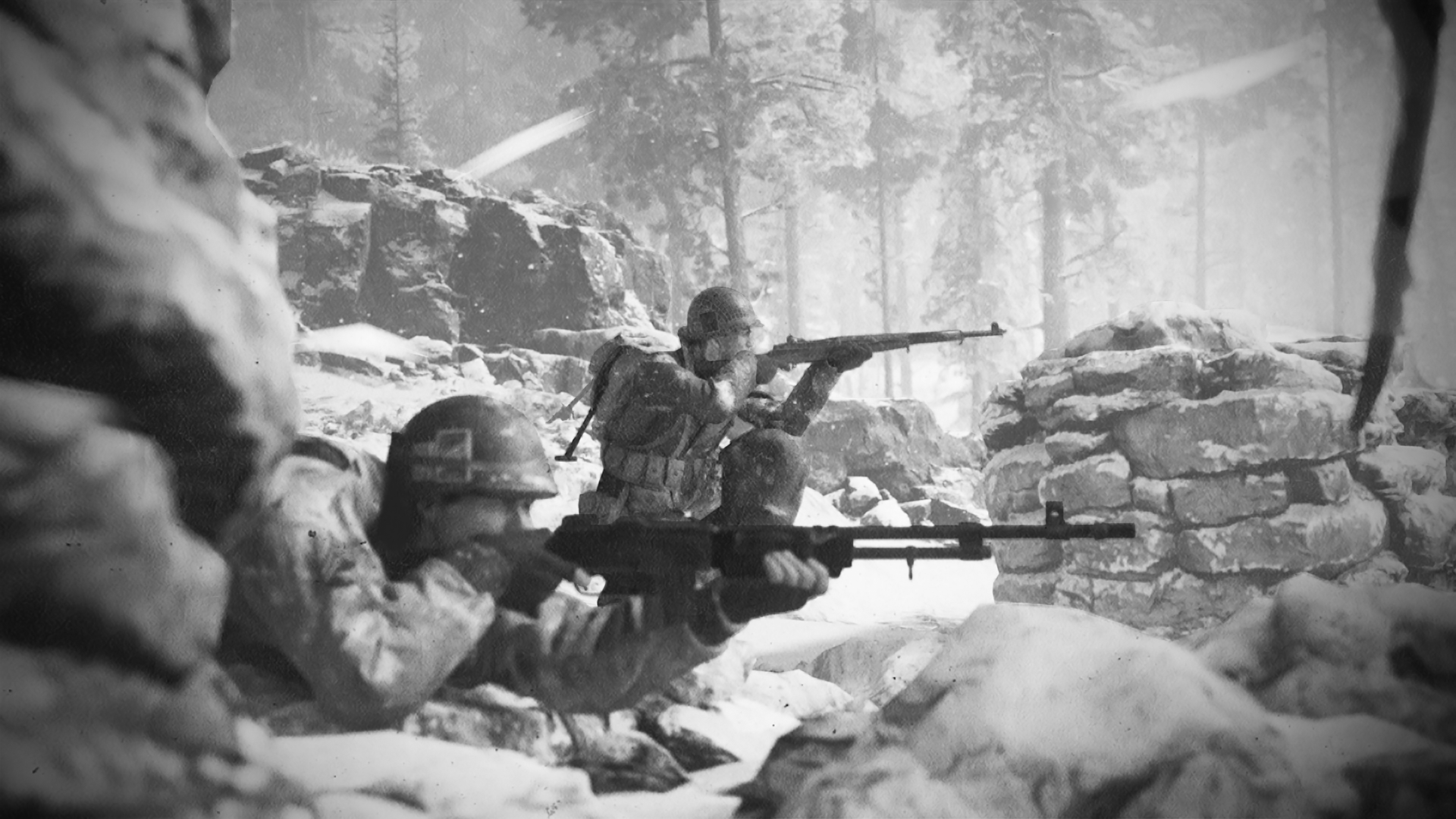
.jpg)
In December of 1944, Hitler had a counterattack. Allied troops were near the Alps. German forces massed near the Ardennes. Hitler wanted English speaking German soldiers in U.S. uniforms to cause confusion. The counterattacks were known as the Battle of the Bulge. It almost succeeded. The Nazis caught the Allied by surprise. It caused bulge in the American line. The Nazis captured many cities. At the Belgian town of Bastogne, Americans forced held onward despite German assaults and frostbite. On December 23, the American forces attacked German forces when the weathered cleared up. The Allies came on the offensive after reinforcements came through. It pushed the Nazis out of France. The Battle of the Bulge was one last attempt of the Nazis to create a division among American plus British forces. It ultimately crippled Germany. It shortened the time of the defeat of Hitler. By January 1945, the Soviet Army came into the Oder River outside of Berlin. The Allies came northward in Italy. In April 27, 1945, Mussolini tried to flee to Switzerland. He was captured and executed in Italy (along with his mistress Clara Petacci) on the date of April 28, 1945. American and British troops in April crossed the Elbe River. This was 50 miles from Berlin. Allied forces were ready to go into Hitler’s capital. Hitler by this time had tremors, he was drug addicted, and still desired victory. No one followed his orders. No one would fight for him. By April 30, 1945, Hitler and his closest allies committed suicide. It was finally over when a murderer and a racist was gone from the Earth. By May 7, 1945 Germany surrendered at French schoolhouse at Eisenhower’s headquarters. Americans celebrated as VE day or Victory in Europe. This came sadly after FDR passed away. A few weeks ago, he or Franklin Delano Roosevelt passed away on April 12, 1945. The new President or Harry Truman saw this victory.
Americans had huge advances in the Pacific too. The Allies used the island-hopping strategy. This was about Americans and other Allied forces taking Japanese held islands and ignoring others in a way to get to Japan. American forces defeated the Japanese at Tarawa, Makin (in the Gilbert Islands), etc. Eniwetok and Kwajalein in the Marshall Islands were liberated by Americans too. Later, Americans came to Saipan, Tinian, and Guam in the Mariana Islands. Japanese troops would fight to the death. Navajo troops in code talks helped the Pacific island hopping campaign. They used their own coded language and the Japanese were confused in what they were saying. They were crucial in the war effort. Japanese forces used suicide bombers called the kamikaze to attack American ships. Japanese soldiers would kill themselves. More than 3,000 Japanese pilots died in Kamikaze actions. General Douglas MacArthur retook the Philippines. The United States Navy sank Japanese ships.
By February and March of 1945, there was the battle of Iwo Jima. It was fierce. It took 36 days of fierce fighting and more than 23,000 U.S. Marine casualties to allow the Americans to win. The famous photograph of six Marines was shown to the world. One person placing the American flag upward was the Native American Ira Hayes. The photograph showed the heroism and the sacrifice of American soldiers. Iwo Jima was 650 miles southwest of Tokyo. The fight for Okinawa came in April of 1945. It was more deadly and was 340 miles from Japan. Okinawa had an air base and it was used for the invasion of Japan. It was very costly which took a half of a million troops and 1,213 warships. U.S. forces took Okinawa at about 50,000 casualties came afterwards. From Okinawa and other Pacific bases, American bombers hit factories, military bases, and sites. One night in March of 1945, B-29 bombers destroyed 16 square miles of Tokyo. This single night of the Allied bombings of Tokyo killed over 83,000 Japanese people and injured 100,000 more. That was an explicit war crime. The atomic bomb ultimately ended World War completely.
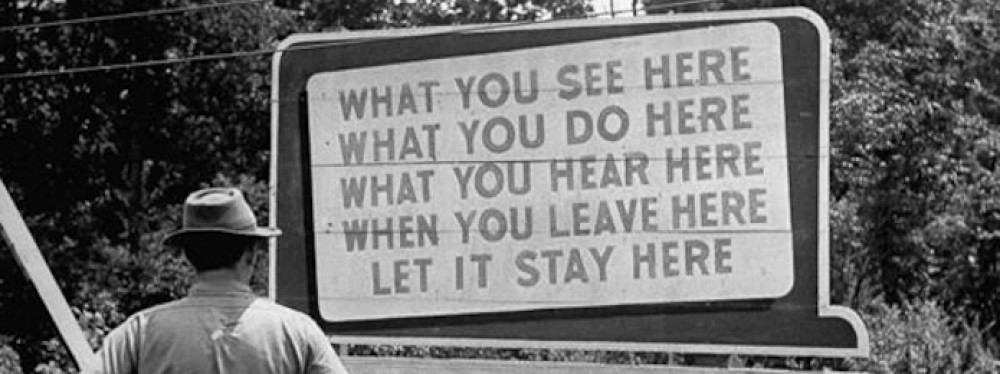

The Manhattan Project helped to form the atomic bomb. The scientists of the 1930’s helped to split the nuclei of elements. Once, Albert Einstein wrote a note to FDR to desire him to advance nuclear weapons. The Manhattan Project spent billions of dollars and involved thousands of people. General Leslie Groves and the liberal scientist J. Robert Oppenheimer worked on it. Los Alamos, New Mexico was the site of the test. Groves promoted security, recruited scientists, and acquired the materials. Oppenheimer ran the scientific part of the project. On July 16, 1945, the first atomic test was enacted. It caused flash of light seen 180 miles away and the sound was heard from 100 miles away. The test was the beginning of the end of the war. Harry Truman knew of the ethical debate about doing this and he realized that this destructive weapon would cause tons of civilians to die. He knew that Axis scientists worked on nuclear technology too. Truman's military advisers wanted him to drop the atomic bomb in Japan since they believed that over 1 million American troops would be necessary to invade Japan and win without the bomb. Recent historians knew that certain actions would end the war sooner against Japan without dropping both nuclear bombs. Truman also wanted to show the Soviet Union that he had this power in order for it to comply with its promise to invade Japanese controlled territory. On August 6, 1945, U.S. pilots dropped the atomic bomb at Hiroshima. It exploded at 8:15 am. It killed thousands instantly. Within 2 minutes, more than 60,000 Hiroshima residents died or were missing out of 344,000 people. On August 9, the Soviet Union declared war against Japan and invaded Manchuria. Later, the U.S. dropped the second atomic bomb at Nagasaki killing 35,000 people. These atomic bomb drops were brutal and overt crimes against humanity. Japan surrendered by August 15, 1945, It was VJ Day or Victory in Japan. Japan surrendered completely on September 2, 1945 aboard the USS Missouri.
The bloodiest war in world history was over. As high as 80 million people (including mostly civilians) died from World War II.

Remembering the Holocaust
The Holocaust was one of the most vicious genocides in human history. It was horrible. Adolf Hitler from the start wanted to exterminate Jewish people in Europe. By the end of the war, 6 million Jewish people and 5 million non-Jewish people were murdered in the Holocaust. The Holocaust or Shoah represents the evil racism and murderous actions of the Nazis. Edward R. Murrow described the scene of one concentration camp at Buchenwald as the most horrific chapter of the Nazis era. The Nazis believed in the lie that Aryans or Germanic, Nordic, and Anglo-Saxon peoples were superior to everyone else on Earth (and must rule the Earth). Hitler preached anti-Semitism. Hitler blamed Jewish people for economic problems, for communism, and for many things. During the 1920’s, he gave speeches hating Jewish people. Hitler persecuted Jewish people immediately when he came into power by 1933 when he was the chancellor of Germany. Hitler started by wanting Germans to have an economic boycott of Jewish owned businesses. He banned Jewish people from having jobs in civil service, banking, stock exchange, law, journalism, and medicine.
In 1935, Hitler promoted the Nuremberg Laws. Nuremberg was one larger center of Nazism. The Nuremberg Laws banned German citizenship to Jewish people, it banned marriages between Jewish people and non-Jewish people, and it segregated Jewish people in every part of society. Later, Hitler promoted the Final Solution. This was the attempt to exterminate Jewish people in Europe. Hitler promoted anti-Semitic campaigns in his government. Newspapers slandered Jewish people. The Hitler youth movement accused Jewish people of polluting Germany society and culture. Comic books have racist, caricatures of Jewish people. One of the early acts of violence against Jewish people was called Kristallnacht on November 9, 1938. That was the Night of Broken Glass. A Jewish refugee killed a German diplomat in Paris. Then, Nazis ordered attacks on Jewish people in Germany, Austria, and Sudetenland. Secret police and military united destroyed more than 1,500 synagogues and 7,500 Jewish owned businesses. They murdered more than 200 Jewish people and injured more than 600 others. The Nazis arrested thousands of Jewish people.
Jewish people tried to flee Germany and Nazi occupied Austria from 1933 and 1937. 129,000 Jewish people wanted to flee. Albert Einstein fled too. Many Jewish people weren’t welcomed in other nations. During the Great Depression, the U.S. and other nations barred many Jewish people from coming into America. The St. Louis ocean liner in 1939 had many in more than 900 Jewish refugees on it. Only 22 were given permission to stay in Cuba. U.S. officials refused to accept any refugees. The ship returned to Germany. Almost 600 of the Jewish people on the St. Louis would be murdered in Nazi concentration camps. In 1933, Nazi Germany not only denied Jewish people citizenship rights, but promoted concentration camps to exterminate Jewish people. Hitler wanted all Jewish people to be murdered in the Third Reich. The early camps were in Dachau, Sachesnhasuen, and Buchenwald.

Later, Reavensbruck not far from Berlin had women prisoners for extermination. The camps had political opponents like labor leaders, socialists, liberals, and communists. Anyone who opposed the Nazis from journalists, novelists, ministers or priests were in concentration camps too. Many Jewish people including non-Jewish people who dated or married Jewish people were placed into camps too. The Nazis murdered Gypsies, Jewish people, Jehovah’s Witnesses, homosexuals, homeless, those with mental illness, the poor, conscientious objectors, the physically disabled, communists, socialists, progressives, black people, and other human beings. Prisoners in camps were tattooed numbers n their arms. Many had triangular insignias. Jewish people had yellow insignia, homosexuals had pink ones, political prisoners had red, and Jehovah's Witnesses had purple. Sadistic guard beat, tortured, and raped prisoners. Some prisoners experienced experiments on oxygen deprivation, hypothermia, and effects of attitude. Some prison guard killed infants and did sick experiments on babies. Children were murdered too. Germany invaded Poland made more Jewish people to be forced into ghettos or crowded areas. More camps existed in Poland and Eastern Europe. Reinhardt Heydrich was involved in the Holocaust after the Wannese Conference in January of 1942. He was an SS leader.
Poland had death camps. The largest death camp was in southern Poland at Auschwitz. Others camps were in Treblinka, Maidenek, Sobibor, Belsec, and Chelmno. Many people were sent to death camps and murdered. Some were poisoned in showers with carbon monoxide or Zyklon B. Some Jewish people were shot and placed into ditches. The human fat form the bodies were turned into soap. Human hair was woven into wigs, slippers, and mattresses. Gold fillings and rings were stolen by the Nazis. Bodies were burned. 6 million Jewish people were murdered by 1945. 2 million non-Jewish Polish people were murdered too Survivors told stories of suffering and pain. Many of them moved into United States, Israel, and other places to be productive people.
The truth is that the United States, Britain, and France of course didn’t do enough to stop the Holocaust. The early response was disgraceful. The United States had strict immigration laws. Even as late as 1943, the American government knew of the Holocaust and did no concrete action to oppose it. By early 1944, FDR created the War Refugee Board to try to save thousands of Eastern European Jewish people, especially in Romania and Hungary. Too few were saved. The Soviet Union with Stalin showed no concern about the death camps. Britain and America had sympathy, but focused more on defeating Hitler while not his genocidal campaign. The Allies refused to pressure countries within the Nazi controlled areas to stop the transportation of Jewish people to Germany. Later, American soldiers liberated many Nazi camps. They saw the bodies. Many of them realized that this evil was real. Major Richard Winters defended Bastogne at the Battle of the Budge and was shocked at seeing the survivors of the Holocaust. The liberation of camps by Americans caused the survivors to go into America and the Americans saw how vicious the Holocaust was. The Holocaust inspired support of an independent Jewish homeland. By 1948, the State of Israel was created and one U.N. resolution supported the establishment of both a Jewish and Palestinian state. Truman immediately recognized the new nation of Israel. The Holocaust was evil and we remember it in order for us to prevent such a genocide from ever happening again.

The Aftermath of World War II
World War II changed the world forever. Many Americans promoted democracy and freedom at home and abroad. Also, the new internationalized world was a complex reality. World War II was not like World War I in many ways. By 1918, the Kaiser surrendered before the Allies invaded Germany. World War II involved the Allied forces invading Germany and Japan in order to end Hitler, Mussolini, and Tojo. Allied bombings and Allied forces ended the Axis powers. Hitler committed suicide and Germany finally surrendered. Japanese refused to surrender until after the bombings of Hiroshima and Nagasaki. The Allies made future plans on what to do after World War II as soon as the Yalta Conference transpired by February of 1945. This was when Roosevelt, Churchill, and Stalin discussed plans on what to do about postwar Germany, Western Europe, and Asia. These 3 men met on the Black Sea. The Big Three nations agreed that Poland, Bulgaria, and Romania would hold free elections. Yet, Stalin later reneged on this promise. Roosevelt and Churchill knew that Stalin occupied much of Eastern Europe. The paradox is that Stalin committed violations of civil liberties, but he and his forces heroically defeated the Nazis and contributed heavily to the end of the Nazis. Roosevelt wanted the Soviets to help him defeat Japan. Stalin gave vague promises. July 1945 was the time of the Potsdam Conference. Potsdam is found in a suburb of Berlin. This had Harry S. Truman, Clement Atlee or the Prime minister of Great Britain, and Joseph Stalin. Truman was a hardliner and wanted more agitation against Stalin. Truman knew of the bombing of atomic test. These three men agreed to divide Germany into four zones of occupation. These zones would be made up of the Soviet Union, America, Britain, and France. They wanted new borders and free elections for Poland. They also recognized the Soviets’ right to claim reparations for war damages from the German sector they controlled. Stalin agreed to aid America in fighting Japan.
After World War II, a new situation happened. Plans for the postwar reality after August of 1945 came about. Poland had new lands slightly to the west. The Soviet Union and the former Allies divided Europe into communist and non-communist nations. East Germany was Communist while West Germany was non-Communist. Almost every nation in Eastern Europe was Communist. Many people clashed in Eastern Europe over communism. The Chinese civil war between Nationalists and Communists continued until Mao Zedong won by 1949. General Douglas MacArthur worked in Japan heavily after the war. He headed the military American occupation in the land of Japan. He had leading role in the writing of the new Japanese constitution. That constitution gave women the right to vote, it had democratic reforms, and it banned the armed forces except for defense, and made policies that aided it in its economic recovery. Overt imperialism started to decline. Western European nations had to deal with a new anti-colonial and anti-imperialist movement that legitimately wanted freedom from centuries of oppression. Since the 1400’s, Spain, France, Britain, etc. had massive influence on global affairs. They colonized much of Africa, the Middle East, Africa, and the Americas. They dominated military power and controlled most of the world trade. These countries exploited the Industrial Revolution as a means for these empires to dominate workers and exploit resources for their own interests. The Nazis and Japan showed the world how evil imperialism is.
Colonial peoples after World War II continued their fight for independence. Those in the East Indies wanted to be free from the Dutch. Those in Vietnam didn’t want to see French rule. India, Burma, and the colonies of the Middle East including Africa wanted independence and freedom. The Age of Imperialism was ending. The British Empire, which had the most political power of the 19th century, came out of the war having economic shortages. In decades later, most of its colonies would leave that Empire. The new superpowers internationally were the United States of America and the Soviet Union. The United States was the strongest superpower after World War II. America had no major battle on its continental soil. America’s military radically increased. America became the wealthiest nation in the world by 1945. Much of the war existed in Soviet lands and the Soviets had most of the burden to defeat the Nazis in Europe. The Red Army has the world’s largest military force while America had the atomic bomb.
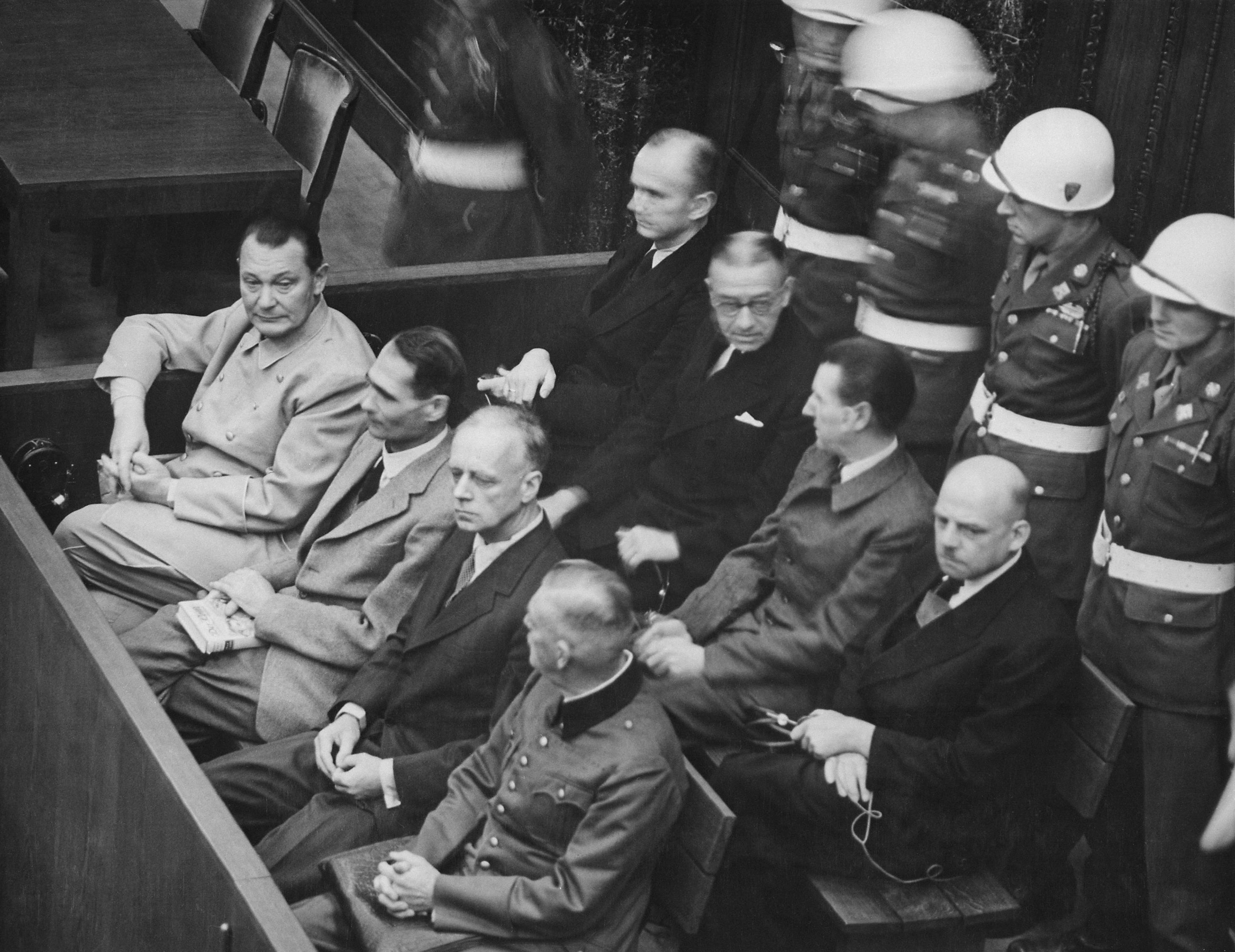
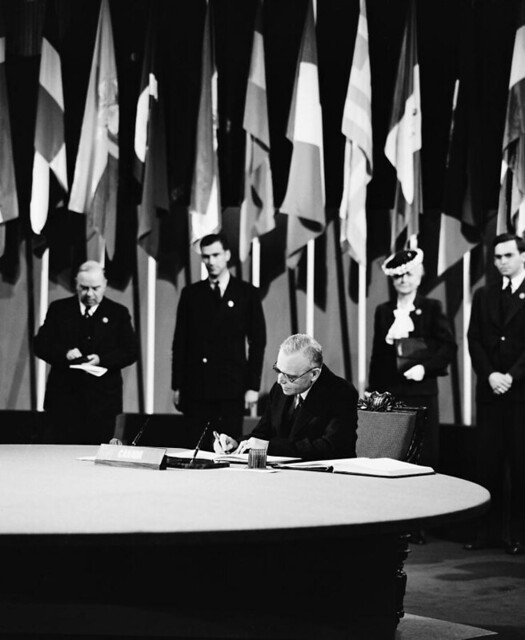
Americans became more receptive to international organizations since they believed that the Senate rejection of the Treaty of Versailles contributed to the rise of fascism in the world. America shaped the international economic system with the Bretton Woods agreement that formed the International Monetary Fund and the World Bank. This meeting to form those groups took place in Bretton Woods, New Hampshire in 1944. The U.S. used a lot of capital to fund global economic and financial stability. They also signed the GATT in 1948 to reduce tariffs. GATT stands for General Agreement on Tariffs and Trade. The United Nations was created in 1945, which was a dream of Franklin Delano Roosevelt. It was much more powerful than the League of Nations. By April 1945, delegates from 50 nations met in San Francisco. In that city, the charter of the UN was written. The Senate overwhelmingly ratified the charter. The UN would have its permanent home in New York City. The United Nations wanted cooperation of large nations originally not necessary promoting the equality of nations. Later, the UN would explicitly endorse human equality. The five permanent members are the United States, the Soviet Union, Britain, France, and China. They were part of the Security Council with massive powers.
Decades later, the UN promoted anti-colonialism, helped to form the state of Israel, handled regional conflicts, and gave food plus other forms of aid to many areas of the world. The UN issued the Universal Declaration of Human Rights in 1948 which promoted human equality explicitly. Eleanor Roosevelt promoted the United Nations. She was the chair of the Commission of Human Rights and helped to draft the Universal Declaration of Human Rights. She promoted equality and women’s rights throughout her life. President John F. Kennedy named Eleanor Roosevelt to head his Commission of the Status of Women. The Universal Declaration of Human Rights condemned slavery, and torture. It promoted the freedom of speech and religion and promoted the right to housing for humanity.
War criminals were punished. The Axis Powers violated the Geneva Convention that dealt with treatment of wounded soldiers and prisoners of war. The Allies tried more than 1,000 Japanese people for their atrocities in China, Korea, and Southeast Asia (including mistreating prisoners of War). Hundreds were condemned to death including Prime Minister Hideki Tojo (and the general who was involved in the Bataan Death March). Americans organized the Nuremberg Trials to convict Nazis involved in the Holocaust and war crimes. The Allied persecutors showed the vicious evil of the Third Reich. Many of those on trial were Hermann Goring. The prosecution described the crimes of the Holocaust. Many of the criminals said that they were following orders and Hitler was the source of the crimes, but these criminals carried out genocide viciously. The Judges of Nuremberg convicted them. Some Nazis were hanged and others had long prison terms. Nazi war crimes are being captured to this very day. Israelis captured Adolf Eichmann, who was the major architect of the Holocaust. He was convicted and experienced the death penalty in Israel.
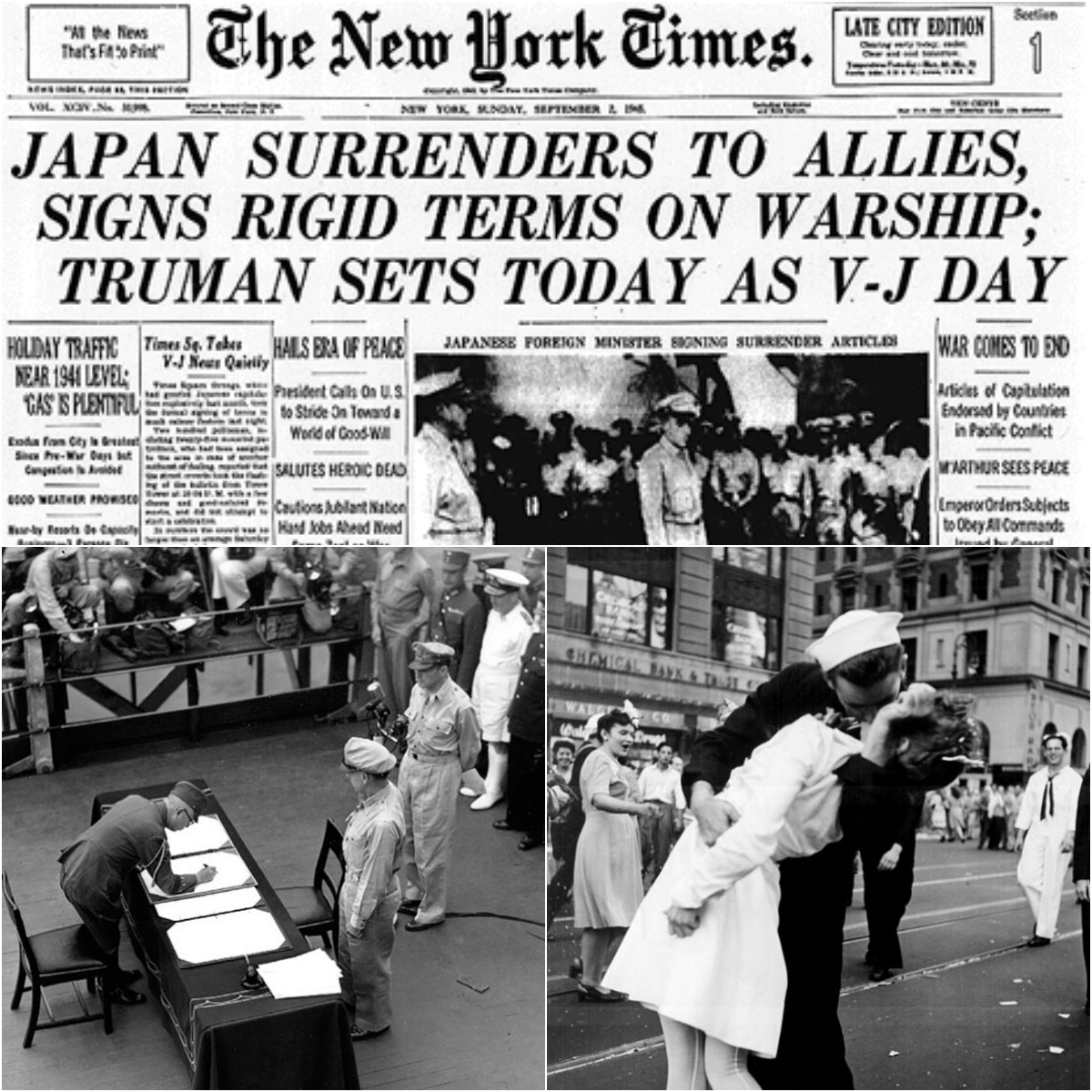

America was changed forever after World War Two. We know of the Nazis as racist, totalitarian, and evil. Many Americans were racist by then. Also, other Americans were democratic, tolerant, and very righteous. Many Americans wanted to promote positive themes in order to rise up to a standard when America at many cases didn’t live up to the values of equality and democracy. American soldiers showed amazing courage during that time period in fighting in North Africa, the Pacific, Europe, and in other places to defeat the Axis powers. The world became more international after WWII. The isolationist mindset declined in American society. America was tied more into international affairs. Also, after the war, a renewal fight for civil rights among African Americans increased. Black Americans continued to fight for freedom. Black people saw World War Two as fighting 2 battles of fascism overseas and racism at home. Many Americans of every color after World War II wanted America to live up to its creed of advancing freedom, democracy, and justice. Economic growth increased after the war. The South and West had industries that inspired people to migrate to those locations. There was an expanded governmental role in the economy in dealing with inflation and raw materials. Postwar America is the beginning of the modern American world that we see today in the 21st century.
By Timothy
Links showing more information are found at:
No comments:
Post a Comment